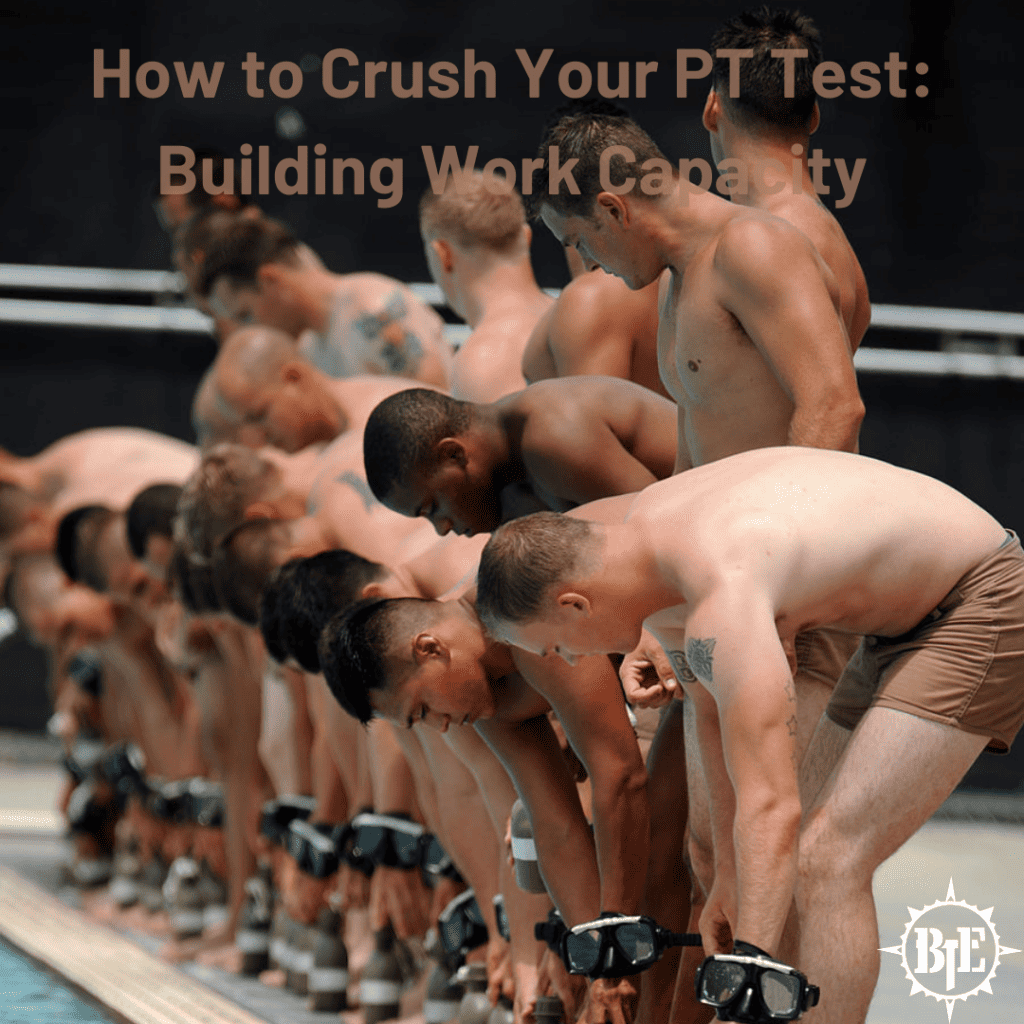What is Work Capacity?
Work capacity is a blend of power and capacity.
- Power = the amount of force you can express in a short, fixed amount of time, such as a max power clean or broad jump
- Capacity = how much force you express repeatedly over a long period of time, such as your 10-mile run time
There is a tradeoff when it comes to either power or capacity within a specific trait. The greater your capacity (amount of work you can do) the lower your max power will be. This is why an ultra-marathon runner might not be able to run a very fast 100m sprint but can run for hours on end at the same pace. Olympic lifters have a ton of power but their capacity in nearly every other area is relatively low (compared to someone with a large capacity).
SOF operators are masters of work capacity. They aren’t overspecialized in any physiological capacity; instead, they can do a lot of everything. This allows them to be extremely adaptable and resilient in the field.
For someone looking to attend a SOF selection course, work capacity refers to your ability to sprint, run, ruck, swim, carry things, climb things, and do calisthenics.
All of these movements require a reasonable amount of force output but are also repeated over and over, requiring a large capacity as well.
Underpinnings of Work Capacity
There are three primary components that dictate your work capacity:
- Aerobic power and capacity
- Movement capacity and fidelity
- Relative strength
If your goal is to crush your PT tests and deal with the never-ending work in selection, you need to have a blend of these three capacities.
1 – Aerobic power and capacity
Most work capacity exercises are high enough in load to force you to recruit type II or intermediate fibers (i.e. fast-twitch or high force output muscle fibers); especially as you fatigue. Thus, if you aren’t strategic about the methods you’re using to develop work capacity you’ll fail to develop the aerobic capacity of your fast-twitch muscle fibers and will quickly hit a wall.
Breathing, another important component of aerobic fitness that is covered in depth here, plays a huge role in work capacity performance. This is especially true during PT tests and repeated beat down sessions meant to stress your ability to recover while still doing work.
The methods described below focus heavily on driving improvements in your underlying physiology and coordination of mental skills to moderate your stress response and breathing.
2 – Movement Capacity and Fidelity
Movement capacity, fidelity, and related concepts were covered in depth here. A quick refresher:
Movement capacity is how well you move:
- Can you do a deep squat?
- Can you lift your arms straight over your head without arching your lower back?
- Can you touch your toes?
More movement isn’t necessarily better, but you need enough to do a deep squat or pull-up without compensations. When you add volume or intensity to your training, small limiting factors in movement lead to excessive strain on tissues in ways they weren’t built to handle. This is when ‘out of nowhere’ injuries occur.
If you’re as flexible as a 2×4 you should focus on developing movement capacity first or you will get hurt if you increase work capacity volume too quickly.
Movement fidelity is how well you can sustain technique under volume and load. Your pullups can’t degrade into a kipping, air-humping mess.
Regardless of what you program, you should always be aware of technique and stop your workouts if / when it starts to slip. And, if you have movement capacity concerns you should address those before incorporating work capacity into your training program.
3 – Relative Strength
Relative strength is simple, it’s a measure of how strong you are relative to your bodyweight. Here are a few examples:
- Pull-ups – 5 chest-to-bar bodyweight pull-ups
- Back Squat – 1.5x bodyweight
- Deadlift – 1.5x bodyweight
- Bench press – 1x bodyweight
Having a solid foundation of relative strength in the basic movements ensures you’ll be able to handle the volume of bodyweight exercises and target the specific physiological qualities each method is designed to stress.
If you don’t have a reasonable strength base upon which to build your work capacity, your work capacity workouts will effectively be strength workouts and you will quickly hit a ceiling.
Movements, Structure, and Frequency
Example Template:
| Exercise |
| Pull-up |
| Pushup |
| Weighted Carry Exercise |
| Plank or Crawl Exercise |
| Shoulder Health Exercise |
| Movement Capacity Exercise |
You’ll notice sit-ups aren’t a part of this structure. Why? Because they are a silly exercise and doing too many will negatively affect your posture and generally beat you up.
You should only do the bare minimum volume to pass your PT test. This is generally accomplished by doing a single AMRAP (as many reps as possible) once per week in the 4-8 weeks leading up to a PT test or prior to selection.
We program anywhere from 0-4 work capacity training sessions per week depending on the individual and where they are at in their training process. Below are basic guidelines based on your capability and where you are at in the training process:
- Strength deficit (not anywhere close to standards) – zero training sessions per week
- Slight strength deficit (within 20% of most standards) – one or two training sessions per week
- No strength deficit (can hit most standards) – two or three training sessions per week
- Peaking – Assuming you’ve prepared properly and are at least close to most standards – two to four sessions per week
As you can see, work capacity has an inverse relationship with strength training sessions. If you’re weak, you should spend your energy improving strength first. If you’re strong, you should focus on improving your work capacity while maintaining strength.
How to Think About Building your Work Capacity
Work capacity sessions are not strength workouts. While they may have a small strength benefit, they primarily stress energy systems, not strength. By slowly ramping up volume within the specific parameters outlined below you can protect quality and avoid burning out due to accumulated fatigue.
The focus of the initial months of work capacity training should be on developing aerobic adaptations in the specific tissues used for the various movements outlined above. These have been labeled as ‘extensive’ methods below.
Once a foundation has been built, you can move on to exploiting those qualities to build the max outputs necessary to smoke PT tests. Think max-rep pushups, pullups, situps, etc. These are labeled ‘intensive methods’. The foundation built during the extensive phase(s) is what is going to help you survive the daily onslaught of beatdown sessions without breaking down.
Extensive Methods:
- HICT: Do a set of 2-5 reps every 10-20 seconds, leading to 12-20 reps per minute for the entire time period. You should be able to maintain perfect technique, but you should feel pretty tired at the end of each movement set. Total volume should be 5-20 minutes.
- Timed Repeats (Alternating): One set of 12-20 reps of pushups is completed as quickly as possible (within 12-20 seconds) followed by a similar set of a pulling exercise (chest supported or inverted rows) during a 1-2 minute rest period. A longer rest period is used initially, but over time the rest period can shrink to as little as 60 seconds. Up to 30 rounds (15 per movement)
- Timed Repeats (Single Movement Focus): Total work time for each set is constrained to the 8-15s range and rest lasts from 60-120s per set. This can be repeated for up to 15 total sets per movement.
- Eustress: A set number of reps are performed throughout a workout with only as much rest as is needed to maintain quality and composure. Reps should be kept even throughout and shouldn’t be anywhere close to your max output (i.e. sets of 5 pullups for 50 reps). Volume will vary depending on the exercise:
-
- Pull-ups: 20-100 reps
- Pushups: 50-200 reps
- Inverted Rows: 50-200 reps
-
Intensive Methods:
- AMRAP: These sets are great for ‘practicing’ your PT test methods and strategies. They are very stressful though, so AMRAP sets should be limited to 1-2 sets of an exercise in a single workout and only be done twice per week at most, and usually only once per week. When executing an AMRAP set, this shouldn’t be the absolute most reps you can do, but the most you can do continuously without grinding out reps.
- Volume-Based Training (VBT): Volume-based training is simple: do the set volume throughout a workout by breaking it up into manageable chunks. Oftentimes volume training is combined with AMRAP training by having the athlete do a single AMRAP set followed by a total volume of work afterward. This method is similar to eustress workouts, but the volume per set is higher. The goal is to finish the total reps in the least amount of sets without compromising technique or falling off a cliff with reps per set. Total volume guidelines from the Eustress method can be used for each movement.
- Breathing Ladders: A listed number of reps are performed followed by the same amount of breaths before the exercise has to be done again. Breathe through the nose. Longer breaths mean more recovery time, so the better your self-regulation under stress the more rest you get. Reps vary by going up and down a ‘ladder’ throughout a set. For example, a 1-5-1 ladder would consist of one rep, rest for one breath, 2 reps, rest for 2 breaths… continue up to 5 reps, and then back down to 1. You can breathe freely while working, but your rest intervals are defined by how long it takes you to complete the prescribed breaths. Total volume guidelines from the Eustress method can be used for each movement.
- EMOM: Every minute on the minute. For these workouts, you do the prescribed reps at the top of each minute for the listed duration of time. Since recovery time is low, the total rep count has to be limited to the 10-15 rep range for pushups and 5-10 reps for pull-ups. Recommended volume:
-
- 6-12 minutes total
- Can be broken into two shorter sets with 4-5 minutes rest between sets
-
Putting it all together
You should now have a comprehensive understanding of how to create work capacity training. As you start building these workouts focus on building volume using extensive methods in your initial phases. Once you can handle the higher volume ranges outlined in the methods above you are ready to transition to intensive methods.
BTE Training App
Everything you need to improve mental & physical performance, in one place. The BTE App will deliver affordable, individualized, and comprehensive training programs.




Hi guys, loved the book. Using the exercise template listed here, would that be for example: push ups and pull ups done as say HICT or Eustress. Would you then have to do weighted carries and plank/crawl as timed repeats or something else? I take it the shoulder health and movement capacity would just be a few reps/sets tagged onto the end or do they follow one of the methods too?
You are correct – that’s how we think about it.
The shoulder health exercises are usually 2-4 sets total. The specific exercises chosen, volume prescribed, and focus (e.g. breathing during weighted carries) will vary depending on the person and how close to their PT test or selection they are.